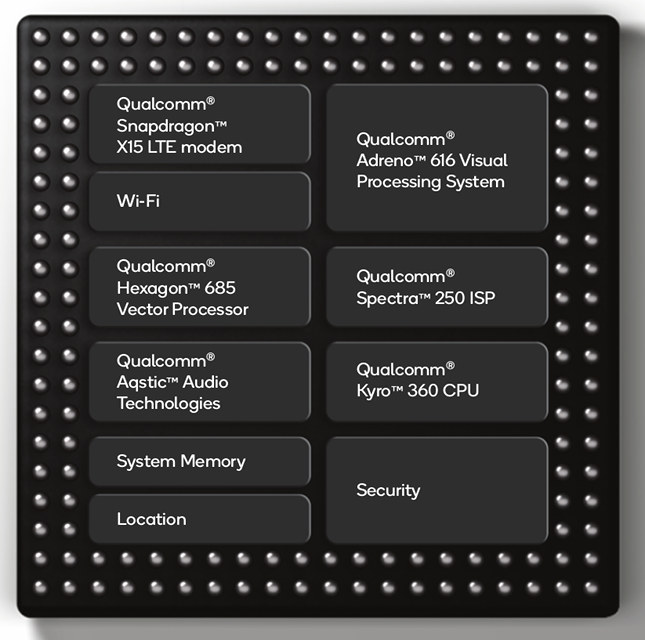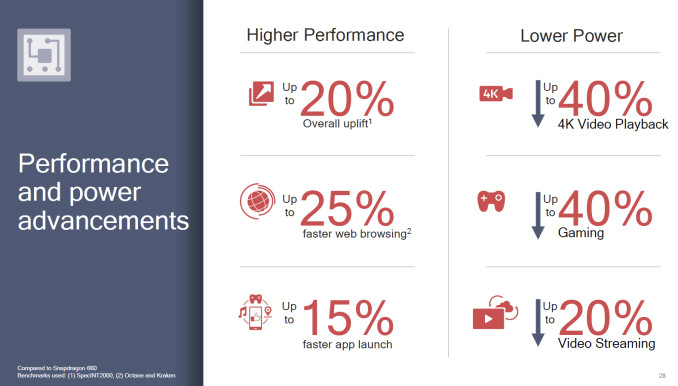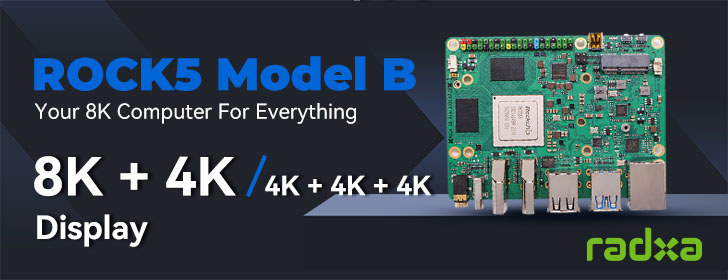Neural processing units (NPU) – also called Neural network accelerators (NNA) – can now be found in all premium smartphone SoCs in order to assist with artificial intelligence applications such as object recognition, face unlock, and better photography.
There seems to be a trend now to add such AI accelerators into what some refers to as mid-range premium smartphones, and Qualcomm Snapdragon 710 mobile platform is another of those processors placing itself between mid range Snapdragon 600 series and premium Snapdragon 800 series.
Qualcomm Snapdragon 710 mobile platform (SDM710) specifications:
- CPU – 8x Qualcomm Kryo 360 CPU @ up to 2.2 GHz (in two clusters)
- GPU – Qualcomm Adreno 616 Visual Processing Subsystem supporting OpenGL ES 3.2, OpenCL 2.0, Vulkan, DirectX 12
- DSP – Qualcomm Hexagon 680 DSP with 3rd Gen Qualcomm Hexagon Vector Extensions (HVX), Qualcomm All-Ways Aware Sensor Hub
- Memory I/F – LPDDR4x, 2x 16-bit up to 1866MHz, 8GB RAM
- Storage I/F – No info provided
- Display – Up to Quad HD+
- Video
- Up to 4K Ultra HD Premium playback
- Up to 4K UltraHD capture @ 30 FPS
- Up to 1080p video capture @ 120 FPS
- H.264 (AVC), H.265 (HEVC), VP9, VP8
- Camera
- Qualcomm Spectra 250 ISP supporting up to 32 MP single camera, up to 16 MP dual camera
- Zero Shutter Lag, Hybrid Autofocus, Motion Compensated Temporal Filtering
- Ultra HD 4K video capture at 30fps
- Accelerated Electronic Image Stabilization
- Audio – Qualcomm Aqstic & aptX audio technologies
- Cellular Connectivity – Qualcomm Snapdragon X15 LTE modem with peak download speed of 800 Mbps, peak upload speed of 150 Mbps
- Other Wireless Connectivity
- Integrated 2×2 802.11ac Wi-Fi with Mu-MIMO up to 867 Mbps via WCN3680B
- Bluetooth 5 up to 2 Mbps, also via WCN3680B
- NFC
- GNSS – GPS, GLONASS, Beidou, Galileo, QZSS, SBAS
- Security – Qualcomm Processor Security, Qualcomm Fingerprint Sensors, Application Security, Hardware Token, Camera Security
- Charging – Qualcomm Quick Charge 4+ technology for a 50% battery charge within 15 minutes.
- Manufacturing Process – 10nm LPP from Samsung
Anandtech provides some extra info about the processor part, with a high performance cluster of two Kryo 360 processors derived from Cortex A75 and clocked up to 2.2 GHz, and a power efficient cluster with six Kryo 360 cores based on Cortex A55 IP and clocked up to 1.7 GHz.
The Snapdragon 710 is a successor to the Snapdragon 660, and Qualcomm states the new processor is up to 25% faster for web browser, up to 40% more efficient for 4K video playback and gaming, and twice as fast when it comes to AI applications.
The Snapdragon 710 Mobile Platform is expected to be found in consumer devices in Q2 2018.

Jean-Luc started CNX Software in 2010 as a part-time endeavor, before quitting his job as a software engineering manager, and starting to write daily news, and reviews full time later in 2011.
Support CNX Software! Donate via cryptocurrencies, become a Patron on Patreon, or purchase goods on Amazon or Aliexpress






I was working @ Qualcomm when the VP of marketing or whatever said noone would ever need 8 cores. Figured that wouldn’t last.
Looks like this system has symmetric cores, all the same, not a collection of fast and slow ones. They took their power management back into hardware a couple years ago, and it must be working well to allow them to make all of them full featured, rather than a mix.
That’s a 2 fast cores + 6 efficient cores design
Exactly, that’s a highly-asymmetrical dynamIQ design. I think the times of 2×4 A53/A55 setups in mid-range are approaching their end.. Who’d have thought getting litho down to 10nm would allow ‘big’ cores in mid-range phones.. ; )
Since dynamIQ claims to cure the big little high speed over heating problem, will we see a 8 x A55 TV SoC at a higher 14 nm?
DynamIQ addresses the big.LITTLE partitioning limitations, not sure what you mean by ‘overheating problem’ — what overheating, in what cases?
People still don’t need 8 cores in phones. This is just for marketing purposes and cores are cheap.